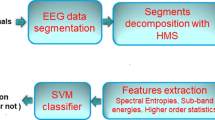Abstract
This study investigates the sensitivity and specificity of predicting epileptic seizures from intracranial electroencephalography (iEEG). A monitoring system is studied to generate an alarm upon detecting a precursor of an epileptic seizure. The iEEG traces of ten patients suffering from medically intractable epilepsy were used to build a prediction model. From the iEEG recording of each patient, power spectral densities were calculated and classified using support vector machines. The prediction results varied across patients. For seven patients, seizures were predicted with 100% sensitivity without any false alarms. One patient showed good sensitivity but lower specificity, and the other two patients showed lower sensitivity and specificity. Predictive analytics based on the spectral feature of iEEG performs well for some patients but not all. This result highlights the need for patient-specific prediction models and algorithms.



Similar content being viewed by others
References
Jeong S, Kim S, Kim D, Youn CH, Kim YW. A personalized healthcare system for chronic disease care in home-hospital cloud environments. In: International conference on ICT convergence. 2013. p. 371–76.
Gandhi M, Singh S. Predictions in heart disease using techniques of data mining. In: International conference on futuristic trends on computational analysis and knowledge management. 2015. p. 520–25.
Fisher RS, Boas WvE, Blume W, Elger C, Genton P, Lee P, Engel J. Epileptic seizures and epilepsy: definitions proposed by the international league against epilepsy and the international bureau for epilepsy. Epilepsia. 2005;46(4):470–2.
Mormann F, Andrzejak RG, Elger CE, Lehnertz K. Seizure prediction: the long and winding road. Brain. 2007;130(2):314–33.
Scheffer M, Bascompte J, Brock WA, Brovkin V, Carpenter SR, Dakos V, Held H, van Nes EH, Rietkerk M, Sugihara G. Early-warning signals for critical transitions. Nature. 2009;461(7260):53–9.
Andrzejak RG, Chicharro D, Elger CE, Mormann F. Seizure prediction: any better than chance? Clin Neurophysiol. 2009;120(8):1465–78.
Iasemidis LD, Sackellares JC, Zaveri HP, Wlliams WJ. Phase space topography and the Lyapunov exponent of electrocorticograms in partial seizures. Brain Topogr. 1990;2:187–201.
Le Van Quyen ML, Martinerie J, Baulac M, Varela F. Anticipating epileptic seizures in real time by a non-linear analysis of similarity between EEG recordings. NeuroReport. 1999;10:2149–55.
Mormann F, Lehnertz K, David P, Elger C E. Mean phase coherence as a measure for phase synchronization and its application to the EEG of epilepsy patients. Phys D: Nonlinear Phenom. 2000;144(3–4):358–69.
Iasemidis L, Shiau DS, Chaovalitwongse W, Sackellares J, Pardalos P, Principe J, Carney P, Prasad A, Veeramani B, Tsakalis K. Adaptive epileptic seizure prediction system. IEEE Trans Biomed Eng. 2003;50(5):616–27.
Freiburg seizure prediction project. http://epilepsy.uni-freiburg.de/freiburg-seizure-prediction-project/eeg-database.
Park Y, Luo L, Parhi KK, Netoff T. Seizure prediction with spectral power of EEG using cost-sensitive support vector machines. Epilepsia. 2011;52(10):1761–70.
Bandarabadi M, Teixeira CA, Rasekhi J, Dourado A. Epileptic seizure prediction using relative spectral power features. Clin Neurophysiol. 2015;126(2):237–48.
Cortes C, Vapnik V. Support-vector networks. Mach Learn. 1995;20:273–97.
Acknowledgements
This work was supported by 2016 Hongik University Research Fund.
Author information
Authors and Affiliations
Corresponding author
Rights and permissions
About this article
Cite this article
Yoo, Y. On predicting epileptic seizures from intracranial electroencephalography. Biomed. Eng. Lett. 7, 1–5 (2017). https://doi.org/10.1007/s13534-017-0008-5
Received:
Revised:
Accepted:
Published:
Issue Date:
DOI: https://doi.org/10.1007/s13534-017-0008-5




